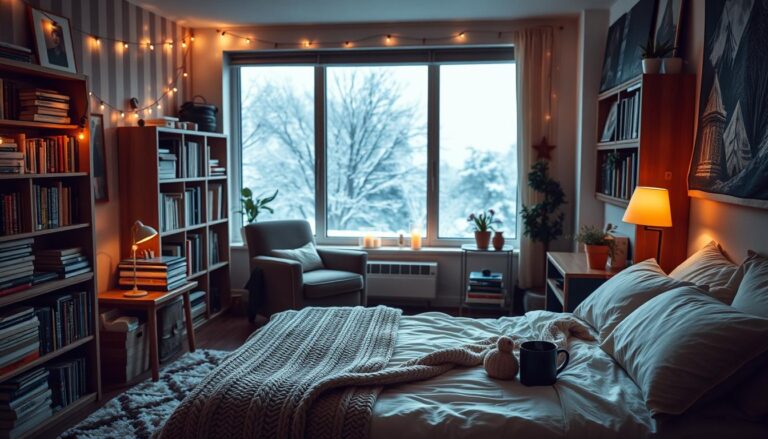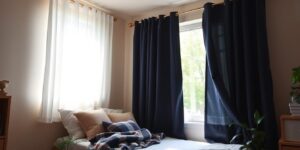How to Design a Calm and Productive Study Corner
Create a calm and productive study corner in your dorm with these inspiring dorm study area ideas. Get tips on designing a space that fosters learning and relaxation.
Creating a clear focus zone in a small room helps students separate work from rest and feel more in control. A dedicated corner can boost motivation, sharpen concentration, and improve time management with a few smart tweaks.
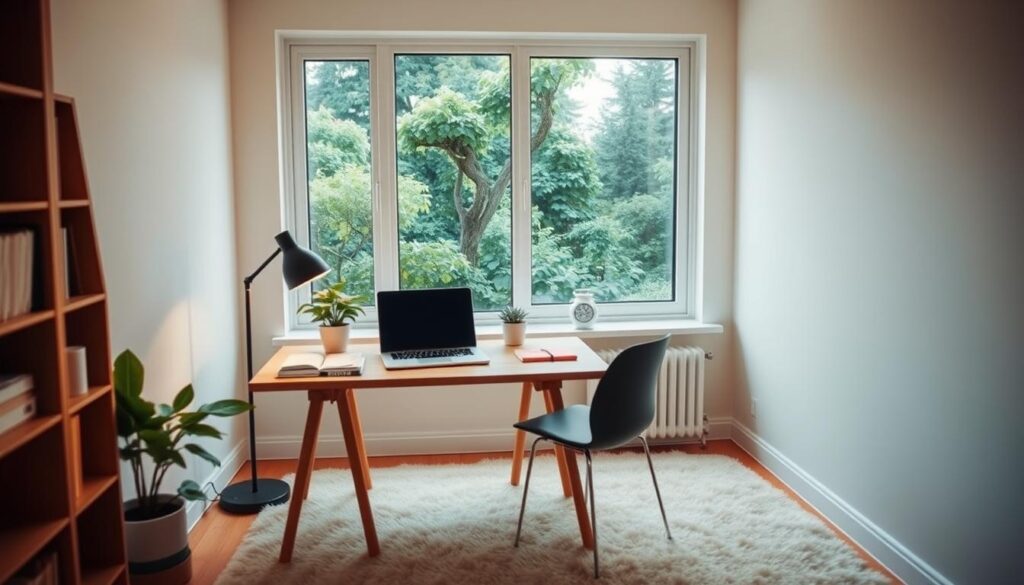
Positioning the desk near natural light and choosing ergonomic furniture supports comfort and better posture during long sessions. Decluttering and using vertical storage like shelves or pegboards frees surface space and reduces visual noise.
Small, renter-friendly upgrades—peel-and-stick wallpaper, washi tape, and a vision board—add personality without damage. Layered lighting from daylight to a focused desk lamp keeps eyes comfortable and energy steady.
Simple cable control and thoughtful tech placement maintain safe walkways and a tidy visual field. Temporary partitions or a rug can mentally signal “focus time” without shrinking the space.
Key Takeaways
- Define a compact work corner to separate tasks and rest for better productivity.
- Place the desk by natural light and use ergonomic seating for comfort.
- Use vertical storage and cable management to keep surfaces clear.
- Add personal touches that are renter-safe to make the space inviting.
- Layer lighting and consider simple partitions to mark focus time.
Understand the Study Intent and Evaluate Your Space First
Start by defining the corner’s purpose—reading, laptop tasks, or drafting—so furniture and flow support the main activity. This clear intent guides measurements, light choices, and safety checks.
Measure walls, floor space, and pathways for a safe, comfortable setup
Measure wall height, available floor, and walking paths to ensure the chair slides and doors open fully. Note ceiling height for tall shelving and hidden storage above the bed or near the ceiling.
What Else Would You Like to Know?
Choose below:
Map natural light from any window to identify the best spot
Observe daylight movement from the window to pick a low-glare corner. Use light-filtering shades if direct sun causes heat or glare. Mark outlet locations and plan cable routes along baseboards.
- Measurements, outlets, and mounting points
- Path clearances and door swings
- Daylight pattern and shadow mapping
- Photos and sketches for later shopping
| What to Check | How to Measure | Why It Matters |
|---|---|---|
| Wall height | Tape from floor to ceiling | Allows tall shelves to free floor space |
| Floor footprint | Outline furniture on grid paper | Prevents blocked pathways and collisions |
| Light path | Note sun angles through the window | Reduces glare and eye strain during study |
| Outlet placement | Map and test power access | Plans neat cable routing and safe setup |
Choose the Right Corner and Layout in Your Dorm Room
Arranging beds and furniture with intent opens up usable floor and creates clear lanes for movement. Picking a layout first helps roommates set expectations and reduces daily friction.
- A standard layout lines beds along opposite walls and uses a curtain or tension rod to add privacy and personal zones.
- An L-shaped plan places beds perpendicular to each other, freeing the center for shared activities or extra pieces.
- Lofting the bed or raising it creates a tucked workstation or storage nook beneath without losing walking space.
Practical placement tips
- Use a tall bookcase or slim dresser as a gentle partition to form a defined lane for focused work.
- Place a trunk at the end of the bed for storage and a secondary surface that won’t add footprint.
- Map outlets and sightlines so the desk faces a blank wall and stays away from social seating or TVs.
| Layout | Best for | Key benefit |
|---|---|---|
| Standard | Privacy seekers | Clear personal zones, simple flow |
| L-shaped | Social sharing | Opens central space for storage or seating |
| Lofted | Small footprints | Extra workspace or storage underneath |
Desk Setup Essentials for Productivity and Comfort
Smart furniture choices can turn a tight corner into a productive, comfortable workstation.
Pick the right compact desk
Choose a narrow, foldable, or corner desk that includes drawers or side cubbies. These options centralize supplies and cut visual clutter. A light finish helps the small space feel brighter.
Select a chair that tucks away
A supportive chair with lumbar support that fully slides under the desk saves floor room. They should check that desktop height lets elbows rest at about 90–100 degrees for proper posture.
Keep accessories minimal and cables controlled
Use a small lamp, one pen cup, and a laptop stand if needed. Route power through a cable organizer along the rear edge so cords never cross walkways.
- Prioritize a compact footprint with built-in storage for daily essentials.
- Store frequent items in the top drawer and less-used tools in side cubbies.
- Consider an adjustable footrest or cushion to increase comfort during long sessions.
| Option | Best for | Key benefit |
|---|---|---|
| Narrow desk | Small corners | Saves floor space, still offers drawers |
| Foldable desk | Multi-use rooms | Stows away when not needed |
| Corner desk | Maximizing wall lines | Creates a concentrated work zone |
Lighting That Boosts Focus Without Eye Strain
Balancing natural and task light keeps the workspace comfortable and productive.
Place the desk by a window to tap natural daylight. This improves mood and energy while working. Add a light-filtering shade or curtain to cut glare and reduce heat during peak sun.
Layer artificial light so the room has depth without harsh contrast. Use an overhead fixture for general light, a focused desk lamp for tasks, and clip-on lights for close work. A strand of soft string lights adds evening ambiance and eases contrast around the study space.
- Orient the desk to avoid direct screen glare from the window.
- Place the task lamp opposite the dominant hand to prevent shadows.
- Choose dimmable fixtures when possible to match time of day.
| Fixture | Best use | Recommended bulb color |
|---|---|---|
| Ceiling light | Even room illumination | Warm-to-neutral |
| Desk lamp | Focused reading or screen work | Warm-to-neutral |
| Clip-on/ambient | Targeted task or mood | Warm-to-neutral |
Keep bulb color consistent across fixtures to maintain reliable color rendering and avoid eye fatigue. Also respect fixture wattage limits for safety and even lighting.
Maximize Vertical Space with Shelves, Pegboards, and Door Organizers
Vertical storage turns empty wall height into practical storage and visual breathing room. This approach keeps the desktop clear while keeping essentials visible and reachable.
Floating shelves and staggered placement
Floating shelves free floor area and display books and gear without cluttering the desk. Place shelves higher on the wall to open sightlines.
Stagger heights and lengths to avoid a heavy, blocky look. Keep heavier items on lower shelves for stability and safety in small rooms.
Pegboards, corkboards, and magnetic boards
Mount a pegboard with modular hooks and cups to park headphones, calculators, and small tools within arm’s reach. Use a cork or magnetic board for schedules, checklists, and note cards.
Boards make routines visible and speed weekly planning.
Back-of-door pockets and renters-friendly fixes
Install a back-of-door pocket organizer for supplies and snacks to reclaim desk surfaces. Group similar items into labeled bins so retrieval is fast.
Match shelf finishes to the desk for a cohesive look. Use proper anchors or removable hardware to protect walls and respect room policies.
- Place heavy items low; light items higher.
- Label bins for fast access to chargers and pens.
- Choose removable anchors when needed to protect painted surfaces.
| Solution | Best use | Key benefit |
|---|---|---|
| Floating shelf | Books, decor | Clears floor and desk |
| Pegboard | Tools, accessories | Customizable, within reach |
| Back-of-door pocket | Supplies, snacks | Reclaims prime desk space |
Smart Storage Ideas Under the Bed and Around the Desk
Maximizing hidden nooks through modular bins and carts keeps essentials handy and surfaces clear. Compact pieces make a big difference in tight rooms. They save time and reduce visual clutter.
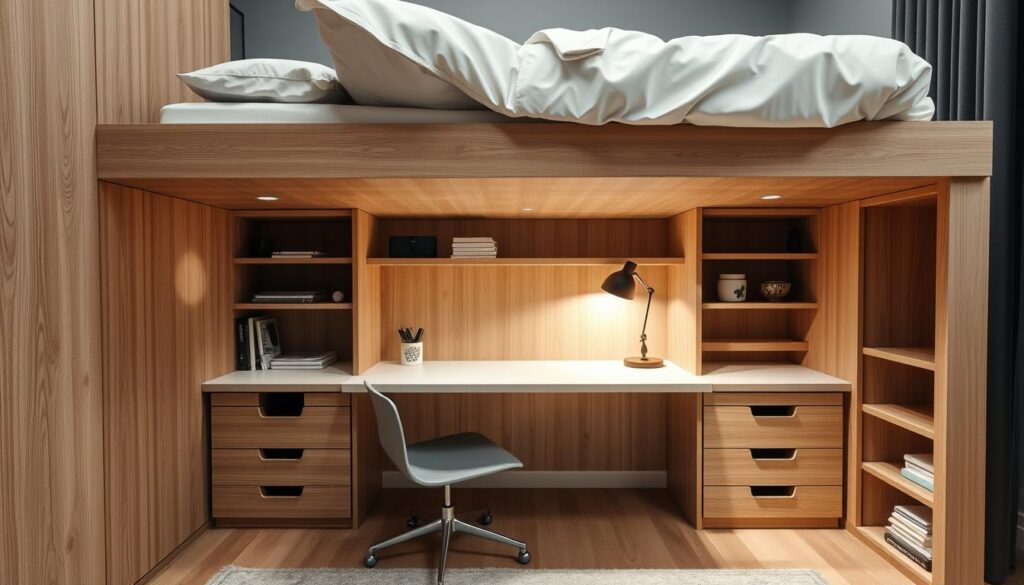
Flexible containers that fit your layout
Cube storage slides under beds or into closets to sort textbooks, cables, and gym gear. Choose shallow boxes for low-clearance frames and deeper cubes for lofted beds.
Mobile and labeled solutions for fast routines
Use a rolling cart as a mobile nightstand to hold water, glasses, and current materials near the desk. A trunk at the bed’s end stores seasonal clothing and doubles as a drop surface for backpacks.
- Label bins for books, gadgets, and stationery to speed transitions between classes.
- Pick clear or mesh containers to see contents at a glance.
- Group chargers and batteries in a spill-proof box to prevent tangles near the desk.
- Add felt sliders to protect floors when shifting storage pieces.
- Set a weekly routine to relabel or reshuffle bins as courses change.
| Solution | Best use | Key benefit |
|---|---|---|
| Under-bed cubes | Textbooks, clothes | Maximizes unused volume |
| Rolling cart | Nightstand, supplies | Mobile and multiuse |
| Trunk | Seasonal items | Extra surface + storage |
Keep Cables and Tech in Check for a Tidy Study Space
Tidy cords and smart power placement make the workspace safer and more calming. A simple plan saves time and protects electronics while keeping the room neat.
Power and placement
Mount a surge-protected power strip beneath or behind the desk to keep floors clear and protect devices. Use right-angle plugs where furniture sits close to outlets to reduce stress on cords.
Clip, label, and consolidate
Route cords with adhesive clips, sleeves, and reusable ties so nothing crosses walking paths. Consolidate charging for laptop, phone, and headphones in one docking spot to speed daily routines.
- Label both ends of similar cables to avoid unplugging the wrong items.
- Coil extra length with reusable ties and store a spare power brick in a pouch.
- Elevate routers and external drives on a small shelf for airflow and dust reduction.
- Create a quick shutdown checklist to power nonessential items and cut background noise.
| Task | Benefit | Tool |
|---|---|---|
| Mount strip | Clears floor, protects devices | Surge-protected power strip |
| Route cords | Reduces trip hazards | Cable clips & sleeves |
| Label cables | Speeds troubleshooting | Sticker labels |
Divide the Room: Simple Partitions That Signal Study Time
A simple partition helps roommates respect quiet hours and creates a clear visual cue for focus. Lightweight options make this change fast and renter-friendly.
Use a folding screen or curtain to section off a compact nook from the sleeping zone in a dorm room. These solutions set a mental boundary without permanent work and fold away when guests arrive.
Place a tall bookcase to form a semi-solid divider that also stores books and supplies. It adds mass for a little sound buffering while keeping essentials within reach.
- Orient the desk so the bed sits outside the main line of sight to reduce distraction.
- Pick light finishes and fabrics so the room does not feel boxed in.
- Choose portable bases that lock or widen for stability in narrow spaces.
- Leave a clear walkway around edges and agree on quiet hours to strengthen the sense of focus.
| Divider | Best for | Key benefit |
|---|---|---|
| Folding screen | Quick setup | Portable, no hardware |
| Curtain | Soft boundary | Light control and privacy |
| Tall bookcase | Storage + partition | Stable, dual purpose |
Color Psychology and Peel & Stick Wallpaper for Calm Walls
Soft, coordinated tones and removable accents turn plain walls into a calm backdrop for work and rest. They help reduce visual noise and support longer focus sessions without major renovations.
Use blues and greens for focus and stress relief
Blue hues promote calm and sharpen attention. Green tones soothe stress and refresh the mind.
Keep large surfaces muted and add small pops of these colors to avoid overstimulation.
Removable peel & stick wallpaper and washi tape for renter-safe style
Peel stick wallpaper panels frame a desk wall as a subtle accent. Washi tape outlines a calendar grid or frames notes without harming paint.
- Choose linen textures or simple geometrics that won’t compete with pinned schedules.
- Test samples on the specific wall finish to confirm clean removal.
- Align seams carefully for a tidy, professional look.
- Coordinate lighting color temperature so materials render true and stay easy to read.
| Option | Best use | Key benefit |
|---|---|---|
| Blue paint tones | Larger visual calm | Improves focus and lowers agitation |
| Green accents | Stress relief | Refreshes mood without overpowering |
| Peel stick wallpaper | Renter-friendly accent | Patterned depth, easy removal |
Textiles, Rugs, and Curtains to Soften Sound and Warm the Floor
Choosing textiles is a simple way to add warmth and absorb echo without permanent work. Thick rugs and light-filtering curtains make shared rooms feel calmer and more inviting while protecting surfaces and improving acoustics.
Fluffy area rugs for noise control and comfort
Place a plush rug under the desk zone to buffer chair movement and add a layer of soft cushioning. Rug pads prevent slipping and add extra cushion for tile or linoleum.
Light-filtering curtains to tame glare and boost privacy
Hang curtains that diffuse direct sun so screens stay readable and daylight still lights notes evenly. Curtains that cover institutional blinds also lift the overall decor without damaging walls.
- Choose low-pile rugs where chairs roll; pick high-pile for lounging items.
- Vacuum rugs often to control dust that can irritate eyes during close work.
- Use washable throws and cushion covers for easy upkeep after long weeks.
- Pick curtain lengths that clear heaters and outlets to balance safety and coverage.
- Consider a door draft stopper, if allowed, to cut hallway noise for a calmer corner.
| Textile | Best use | Benefit |
|---|---|---|
| Thick rug | Under desk or lounging | Warms hard floors; reduces echo |
| Light-filtering curtains | Window coverage | Reduces glare; adds privacy |
| Washable throws | Quick comfort | Easy cleaning; adds cozy layer |
Plants, Personal Decor, and DIY Touches That Motivate
A few living plants and meaningful mementos lift mood and make a workspace feel like home. These small touches add calm without stealing surface room.
Low-maintenance greenery
Spider plants and succulents thrive with minimal care. Place them near indirect light and use saucers to protect finishes from moisture.
Agree on a simple watering schedule with roommates to avoid spills and allergies.
Vision boards and locally inspired decor
Create a large calendar or vision board to keep semester goals visible. Add small local prints or souvenirs to remind students of milestones without crowding the desk.
DIY frames and removable displays
Use tabletop frames and standing shadow boxes to show photos, ticket stubs, and small things without drilling walls. Pick lightweight frames with easel backs for easy moves at checkout.
Group tiny items on a tray to limit visual noise and keep books accessible.
- Limit tabletop decor so the work surface stays clear for books and tasks.
- Rotate seasonal mementos to keep the corner fresh during exam cycles.
- Use trays and easel-backed frames to display keepsakes safely.
| Decor Element | Best placement | Benefit |
|---|---|---|
| Succulents | Window ledge or desk corner | Low water needs; visual calm |
| Spider plant | Near indirect light | Air-purifying; easy care |
| Vision board | Above desk or on shelf | Keeps goals visible; boosts motivation |
| Shadow box/frame | Tabletop or shelf | Displays mementos without wall damage |
Sound Control Strategies for Shared Dorm Rooms
Noise shaping matters: small fixes can cut distractions and make shared rooms feel calmer. Simple textiles and a few removable pieces can change the room’s acoustic profile quickly.
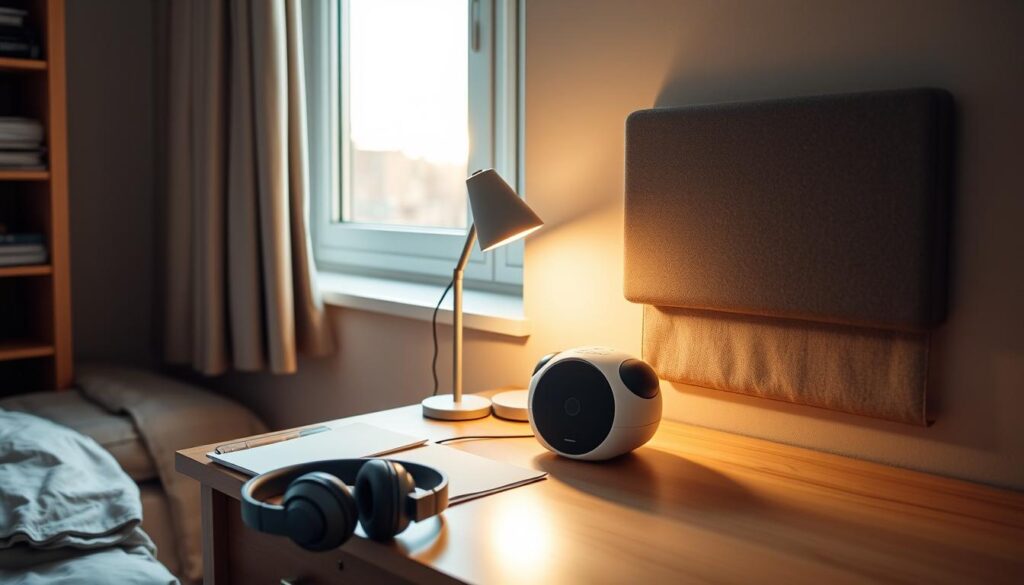
Soft furnishings and acoustic panels to dampen noise
Place dense rugs and layered curtains to absorb corridor and echo. Felt pads under furniture reduce scraping and sudden thumps.
If allowed, add lightweight acoustic panels or foam tiles on a short wall near the study space. Removable panels tame reflections without permanent work.
Noise-canceling headphones for deep-focus sessions
Noise-canceling headphones create a personal quiet zone when roommates are active. Keep a small white-noise playlist as one of the go-to items to mask speech from neighboring rooms.
- Coordinate quiet hours and use door signs for timed focus blocks.
- Avoid placing the desk against thin shared walls; prefer a quieter interior wall.
- Test seating and rug combos to find the best comfort and sound control.
- Maintain headphone hygiene—clean ear pads and rotate use for long comfort.
- Revisit noise control after midterms and shift panels or textiles as routines change.
| Solution | Benefit | When to use |
|---|---|---|
| Dense rug + curtain | Absorbs echo and footsteps | Continuous background noise |
| Removable acoustic panels | Reduces reflections near desk | Allowed by housing rules |
| Noise-canceling headphones | Immediate personal silence | Group activity or loud hours |
Small-Space Optimization: Multifunctional Pieces and Daily Habits
A focused plan that pairs modular furniture with simple daily habits keeps a small corner tidy and ready for work.
Benches with hidden storage and headboards fitted with shelves add capacity without increasing the footprint. Rolling carts shift easily from bedside to desk and act as a flexible supply caddy.
A weekly reset day—declutter, rotate current books, dust surfaces, and restock essentials—keeps items in reach and preserves productivity.
- Choose multifunction pieces that store gear and serve as seating.
- Keep only the current week’s materials at the desk and archive the rest in labeled bins.
- Favor collapsible or nesting accessories that tuck away between sessions.
- Keep a microfiber cloth handy for quick dusting of electronics and shelf edges.
| Piece | Primary function | Key benefit |
|---|---|---|
| Storage bench | Seating + hidden bins | Extra capacity without consuming more spaces |
| Headboard shelf | Books + small display | Keeps essentials within reach |
| Rolling cart | Mobile supply station | Adapts to sleep or work needs |
Once a month they review the layout to see if a small shift improves light, reach, or cable routing way. They also create a short checklist to make sure nothing piles up and swap out over- or under-used items as the semester progresses.
dorm study area ideas: A Curated List to Inspire Your Setup
A few well-chosen combos can turn a tight nook into a bright, functional workspace. Below are compact pairings that balance light, storage, and comfort so nightly routines run smoothly.
Window-facing desk with clip-on lamp and pegboard trio
Place a desk by the window to use daylight, then add a clip-on lamp for late sessions. A pegboard trio keeps tools visible and off the desktop.
Under-bed cube storage plus a mobile cart nightstand
Slide cubes under the bed to store current classes and pair them with a rolling cart that doubles as a nightstand. This setup speeds nightly resets after a long day.
Staggered floating shelves with a corkboard calendar wall
Mount staggered shelves above a corkboard calendar to hold frequently used books and deadlines. The combo keeps plans visible and surfaces uncluttered.
Peel & stick accent wall, mirror placement, and leafy plant corner
A peel & stick accent wall adds color without paint. Place a mirror perpendicular to the window to reflect light, and tuck a low-maintenance plant nearby for calm.
Curtain divider, fluffy rug, and minimalist desktop organizers
Use a curtain to define the corner, add a fluffy rug to soften sound, and keep a minimalist tray with a pen cup and sticky notes to prevent clutter creep.
- A trunk at the bed’s end hides bulk supplies and stages backpacks.
- A tall bookcase works as a screen and adds vertical storage.
- Light-filtering curtains over blinds reduce glare during midday reading.
- A labeled charging shelf consolidates tech for tidy cable management.
| Solution | Best for | Key benefit |
|---|---|---|
| Window desk + pegboard | Daylight tasks | Bright workspace, visible tools |
| Under-bed cubes + cart | Limited floor space | Easy nightly reset, mobile storage |
| Shelves + corkboard | Planning & books | Visible deadlines, cleared desk |
Conclusion
They recommend a measured approach: plan, place, and maintain. First, measure and map outlets, then choose the corner and route cables before moving furniture in the dorm. Small steps pay off fast.
Quick tips include ergonomic seating, a compact desk, layered lighting, and vertical storage like shelves and pegboards. Use peel-and-stick accents and calm hues to create a welcoming home feel without permanent changes.
Soft textiles, partitions, and weekly resets keep distractions low and a clear sense of focus. Make sure to test one change today and iterate as routines evolve to keep the study space practical and lasting.
FAQ
How should they measure their room before choosing a corner for a calm, productive setup?
What layout works best for maximizing privacy and function in a small room?
Which desk and chair features promote comfort and save floor space?
How can they layer lighting to reduce eye strain and boost concentration?
What vertical storage solutions work without causing visual clutter?
How can they keep cables and chargers tidy and safe?
Which removable wall treatments are renter-friendly and calming?
What storage ideas fit under beds and around desks to maximize space?
How can they divide the room to signal study time without permanent changes?
Which textiles help soften sound and warm the floor in a small room?
What low-maintenance plants and decor boost mood without much upkeep?
How can students control noise in shared rooms for better focus?
What multifunctional furniture pieces make the most of very small spaces?
How often should they reset and declutter to keep the workspace functional?
What are simple, DIY-friendly organizer options they can make on a budget?
10 Cozy Decor Ideas for Winter in Your Student Apartment
» See exclusive tips for your home


